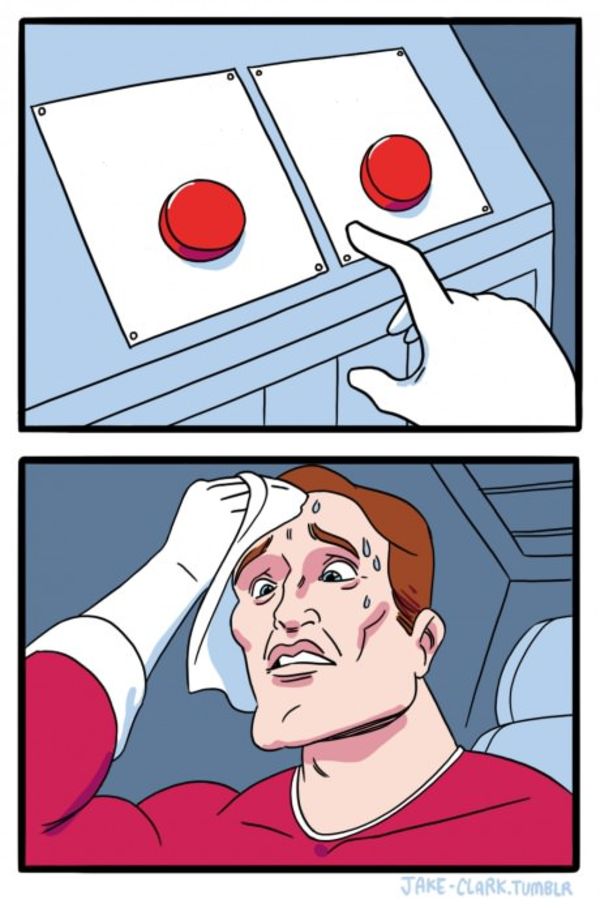
Two Buttons
The "Two Buttons" meme features a cartoon character from the TV show "Daily Lives of High School Boys" (known as "Danshi Kōkōsei no Nichijō" in Japanese), sweating profusely while trying to decide which of two red buttons to press. The character appears extremely distressed by this decision, with sweat pouring down his face as he hovers his hands over both buttons. The meme represents: A difficult or impossible choice between two contradictory options Internal conflict or cognitive dissonance The struggle to maintain inconsistent beliefs or behaviors Being forced to choose between equally appealing or equally unappealing alternatives The human tendency to want incompatible things simultaneously In internet culture, the two buttons are labeled with text representing contradictory choices, beliefs, or actions that someone is trying to reconcile. The sweating character represents the person or group experiencing the dilemma. The humor comes from highlighting hypocrisy, inconsistency in logic, or impossible situations where someone wants to have things both ways. It's particularly effective at calling out political doublethink, corporate contradictions, or personal inconsistencies where someone's desires or claims conflict with each other. The meme's popularity stems from its perfect visual representation of the mental anguish that comes from trying to reconcile opposing ideas or make a choice between mutually exclusive options.
Similar Templates

Two Buttons
The "Two Buttons" meme features a cartoon character from the TV show "Daily Lives of High School Boys" (known as "Danshi Kōkōsei no Nichijō" in Japanese), sweating profusely while trying to decide which of two red buttons to press. The character appears extremely distressed by this decision, with sweat pouring down his face as he hovers his hands over both buttons. The meme represents: A difficult or impossible choice between two contradictory options Internal conflict or cognitive dissonance The struggle to maintain inconsistent beliefs or behaviors Being forced to choose between equally appealing or equally unappealing alternatives The human tendency to want incompatible things simultaneously In internet culture, the two buttons are labeled with text representing contradictory choices, beliefs, or actions that someone is trying to reconcile. The sweating character represents the person or group experiencing the dilemma. The humor comes from highlighting hypocrisy, inconsistency in logic, or impossible situations where someone wants to have things both ways. It's particularly effective at calling out political doublethink, corporate contradictions, or personal inconsistencies where someone's desires or claims conflict with each other. The meme's popularity stems from its perfect visual representation of the mental anguish that comes from trying to reconcile opposing ideas or make a choice between mutually exclusive options.

Two Paths
The 'Two Paths' meme template features a forked road with two divergent paths, often used to depict a choice between two contrasting options. Each path typically represents a different decision, ideology, or potential outcome, and the meme is frequently used to humorously illustrate the dichotomy between two options or behaviors. One side may represent the easier or more appealing choice, while the other side might symbolize the morally correct or challenging decision. The template is versatile and can be adapted to various situations, such as personal decisions, cultural trends, or societal issues. Users place text over each path to denote what each option represents, often leading to humorous or ironic interpretations.

Blank Nut Button
The 'Blank Nut Button' meme template features an image of a blue button with the word 'NUT' on it. The button, usually seen on game show panels, is pressed enthusiastically to indicate a decision or reaction. In meme culture, the 'Blank Nut Button' is used to symbolize a strong impulse or an overwhelming desire to act. Often, people use this template to depict scenarios where immediate or exaggerated reactions are triggered by an accompanying statement or situation. The template is versatile and humorously showcases instincts or decisions made in haste or strong emotion.

UNO Draw 25 Cards
The "UNO Draw 25 Cards" meme features a modified UNO card alongside an image of a person holding many cards. The custom UNO card contains two options: performing a specific action (often something simple but undesirable) OR drawing 25 cards. The second panel shows someone holding a large hand of cards, implying they chose to draw 25 cards rather than perform the stated action. The meme represents: Stubborn refusal to do something simple or obvious Going to extreme lengths to avoid an unpleasant task or admission Choosing a more difficult path over doing something you dislike The humorous lengths people will go to avoid certain behaviors or responsibilities Irrational decision-making driven by personal preferences In internet culture, the first option on the UNO card is labeled with text representing something the subject strongly resists doing, while their large hand of cards demonstrates they'd rather suffer a significant penalty than comply. The humor comes from highlighting how people will often choose objectively worse outcomes to avoid doing things they strongly dislike. This meme effectively captures human stubbornness and the sometimes irrational aversion people have to certain actions or admissions, even when the alternative is clearly worse. It's particularly popular for depicting everyday avoidance behaviors, personal quirks, or the refusal to acknowledge obvious truths.

Two guys on a bus
The 'Two Guys on a Bus' meme is an image featuring a dual-frame scene from the children's book 'Beyond the Glass' by Yasuto Kitade. It depicts two men sitting on opposite sides of a bus; one is looking out the window at a bleak, gray mountainside and appears sad, and the other is looking out the opposite window at a sunny, colorful landscape and appears happy. The meme is often used to convey different perspectives or attitudes towards the same situation. Typically, users add text to each person, with the sad one representing a negative or pessimistic viewpoint and the happy one representing an optimistic or positive perspective.